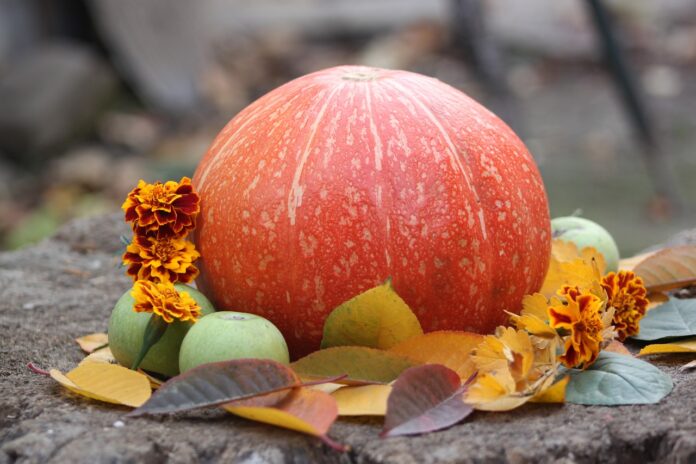Pumpkins are versatile fruits belonging to the Cucurbitaceae family, which includes squash, cucumbers, and melons. Known scientifically as Cucurbita pepo, pumpkins are native to North America and have been cultivated for over 7,500 years. Their defining features include a thick, ribbed orange skin, a hollow interior filled with seeds, and a sweet, earthy flavor. However, pumpkins come in various shapes, sizes, and colors, including green, white, yellow, and even blue varieties.
Interesting Facts About Pumpkins:
- Origins and Name: Pumpkins trace their linguistic roots to the Greek word pepon, meaning “large melon.” French explorers altered it to pompon, which became “pumpion” in English and eventually “pumpkin” in colonial America. Their cultivation dates back thousands of years in North America, where they were integral to indigenous diets
- Ancient Roots: Archaeological evidence places pumpkins among the oldest domesticated plants, with seeds found in caves in Mexico dating back to 7,000 BCE. Early varieties were smaller and more bitter but valued for their nutritional seeds
- Classification: Botanically, pumpkins are fruits because they develop from flowers and contain seeds. They belong to the gourd family (Cucurbitaceae), making them relatives of cucumbers, zucchini, and melons
- Edibility: Nearly every part of the pumpkin can be consumed. The seeds are often roasted or pressed for oil, while the flesh is used in soups, breads, and pies. Even the blossoms are edible and are a delicacy in many cultures
- Water Content: Composed of approximately 90% water, pumpkins are hydrating and low in calories. This high water content contributes to their smooth texture when pureed
- Nutritional Powerhouse: Rich in vitamins A, C, E, and potassium, pumpkins support immune health, vision, and heart function. The beta-carotene in their orange flesh acts as an antioxidant, reducing risks of chronic diseases
- Pumpkin Spice Craze: The blend of cinnamon, nutmeg, ginger, and cloves creates the signature “pumpkin spice.” Though not containing pumpkin itself, this mix dominates fall products like lattes and desserts
- Jack-o’-Lantern Tradition: This iconic Halloween practice originated in Ireland, where turnips or potatoes were carved to ward off spirits. Immigrants brought the tradition to America, where pumpkins proved easier to carve
- Record Breaker: The heaviest pumpkin on record weighed 2,624 pounds and was grown by Mathias Willemijns in Belgium in 2016. Competitions to grow the largest pumpkins are a serious pursuit worldwide
- Pumpkin Pie Legacy: Pumpkin pie, a staple of Thanksgiving, was inspired by early settlers who hollowed out pumpkins, filled them with milk and spices, and baked them in ashes
- Varied Colors: Pumpkins come in shades beyond orange, including green, yellow, white, and blue. White varieties like “Lumina” are popular for decorating, while blue pumpkins like “Jarrahdale” are prized for cooking
- Festivals: Towns across the U.S. hold pumpkin festivals featuring pie-eating contests, carving competitions, and parades. Some events include pumpkin weigh-offs, celebrating the growing of giant pumpkins
- Pumpkin’s Role in Folklore: Pumpkins feature prominently in stories such as Cinderella’s magical carriage and the “Great Pumpkin” in the Peanuts comic strip, symbolizing wonder and imagination
- Culinary Versatility: Pumpkins are used in both sweet and savory dishes, from muffins and pies to risottos and curries. Their seeds are roasted for snacks, while the flesh is pureed for soups or desserts
- Pumpkin Boats: Some festivals host pumpkin regattas, where giant pumpkins are hollowed out and turned into boats for races on lakes, showcasing creativity and buoyancy
- Global Production: The U.S. produces over 1.5 billion pounds of pumpkins annually, with Illinois growing the majority. Pumpkins are a vital agricultural product for canned goods and decorations
- Pumpkin Oil: Valued for its nutty flavor, pumpkin seed oil is popular in European cuisines and is also used in skincare for its moisturizing properties
- Oldest Recipes: Native Americans ate pumpkins roasted, boiled, or mashed, often incorporating them into stews. Early settlers adopted these methods and created new recipes like pumpkin pie
- Largest Pumpkin Pie: Weighing 3,699 pounds, the largest pumpkin pie required 80 pounds of cooked pumpkin and 60 pounds of sugar. It was baked for a fall festival and served thousands of guests
- Symbol of Fall: Pumpkins symbolize harvest and abundance, frequently used in autumn decorations and Thanksgiving displays
- Canned Pumpkin: Most pumpkins grown in the U.S. are processed into canned puree for cooking. Libby’s, a major producer, grows its proprietary variety for consistency
- Beauty Ingredient: Pumpkin enzymes exfoliate skin and promote cell turnover, making them a common ingredient in face masks and scrubs
- Pumpkin Chucking: This sport involves launching pumpkins using trebuchets or cannons at festivals. It highlights both fun and ingenuity
- Historical Use: Indigenous peoples dried pumpkin strips for weaving mats and made roasted seeds into snacks
- Pumpkin Spice Products: Beyond food, pumpkin spice is used in candles, air fresheners, and cosmetics, showcasing its seasonal appeal
- Agritourism: Pumpkin patches attract millions, offering hayrides, mazes, and educational activities that teach sustainable farming
- Pumpkin in Literature: Their magical association appears in stories like Cinderella and the folklore of the “Great Pumpkin,” representing transformation and hope
- Health Benefits for Pets: Pumpkin puree is a common dietary supplement for dogs, aiding digestion and hydration
- Harvest Timing: Pumpkins peak in October, aligning with Halloween and Thanksgiving, ensuring their cultural and culinary prominence
- Pumpkin Education: Schools and farms use pumpkins to teach children about plant life cycles, sustainability, and healthy eating
